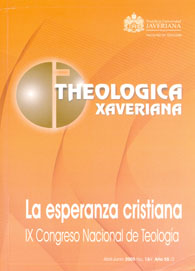Abstract
D espués de repasar algunos hechos, situaciones y acontecimientos, que desde finales del siglo pasado y comienzos de este siglo XXI han llegado a producir una verdadera crisis de esperanza entre los hombres y mujeres de hoy, tanto en el mundo como en nuestro país, el autor se pregunta si la Iglesia tiene algo que decir y ofrecer, como testigo de la esperanza, en estos tiempos de crisis: ¿Puede hoy la Iglesia decir una palabra creíble y ofrecer, a través ella, razones para que los hombres y mujeres de hoy puedan seguir esperando? ¿Qué puede esperar legítimamente la humanidad y, en concreto, nuestro pueblo colombiano, de la Iglesia, como pregonera del anuncio de que Cristo Jesús es nuestra esperanza (cf. 1 Tim, 1, 1)? Piensa el autor que la Iglesia está llamada a ser lo que ella tiene que ser, por deseo expreso de su fundador, y sólo así ella podrá constituirse en un auténtico espacio de esperanza y en constructora de la misma para el mundo de hoy.AGUIRRE, RAFAEL. La mesa compartida. Estudios del Nuevo Testamento desde las ciencias sociales. Sal Terrae, Santander, 1994.
CASTILLO, CARLOS, “Ante los desafíos del tránsito de época: una Iglesia para vivir”, en Cuestiones teológicas y filosóficas 72, 2002.
CASTILLO, JOSÉ MARÍA, La alternativa cristiana, Sígueme, Salamanca, 1978.
CONSEJO EPISCOPAL LATINOAMERICANO, Globalización y nueva evangelización en América Latina y el Caribe. Reflexiones del CELAM, 1999-2003, Bogotá, 2002.
CRUZ, M., Tiempo de subjetividad, Buenos Aires, 1996.
FUKUYAMA, F., El fin de la historia y el último hombre, Barcelona, 1992.
JUAN PABLO II, Carta apostólica Novo Millennio Ineunte, No. 50.
JUAN PABLO II, Exhortación apostólica Ecclesia in America, No. 20.
LOHFINK, GERHARD, La Iglesia que Jesús quería, Bilbao, 1986.
MARDONES, J. M., A dónde va la religión. Cristianismo y religiosidad en nuestro tiempo, Santander, 1996.
MATEOS, JUAN- CAMACHO, FERNANDO, El horizonte humano. La propuesta de Jesús, Córdoba, 2000.
This journal is registered under a Creative Commons Attribution 4.0 International Public License. Thus, this work may be reproduced, distributed, and publicly shared in digital format, as long as the names of the authors and Pontificia Universidad Javeriana are acknowledged. Others are allowed to quote, adapt, transform, auto-archive, republish, and create based on this material, for any purpose (even commercial ones), provided the authorship is duly acknowledged, a link to the original work is provided, and it is specified if changes have been made. Pontificia Universidad Javeriana does not hold the rights of published works and the authors are solely responsible for the contents of their works; they keep the moral, intellectual, privacy, and publicity rights.
Approving the intervention of the work (review, copy-editing, translation, layout) and the following outreach, are granted through an use license and not through an assignment of rights. This means the journal and Pontificia Universidad Javeriana cannot be held responsible for any ethical malpractice by the authors. As a consequence of the protection granted by the use license, the journal is not required to publish recantations or modify information already published, unless the errata stems from the editorial management process. Publishing contents in this journal does not generate royalties for contributors.


